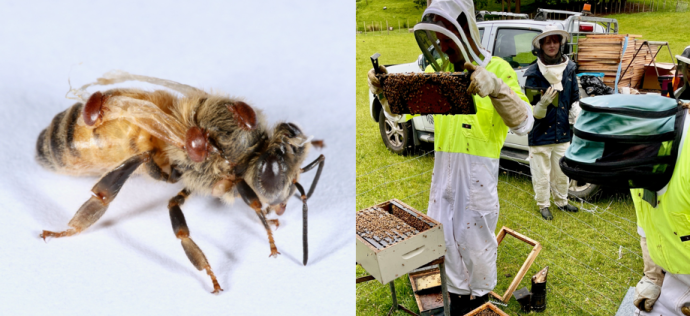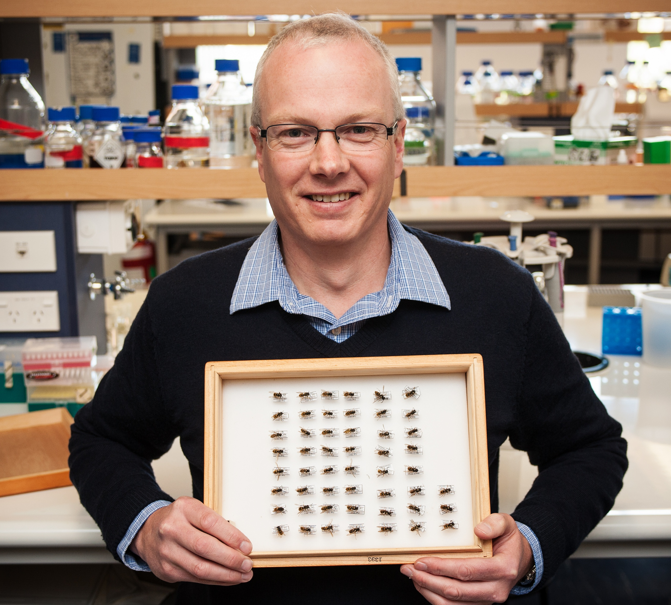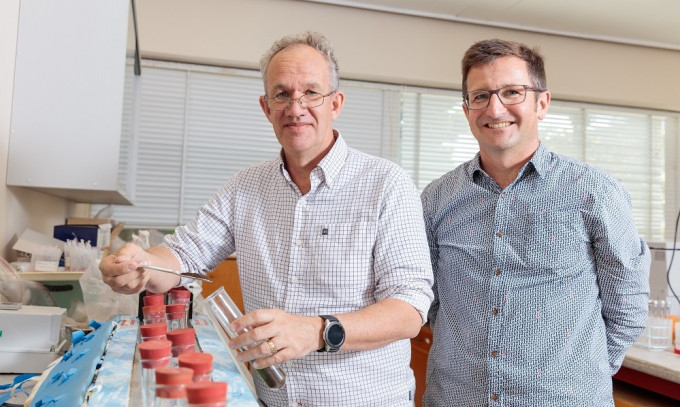Impact story: Ecology in a warming world

Aotearoa New Zealand has stand out research in biodiversity, pollinator networks, and food webs – using new techniques and increasing our understanding of global warming on ecosystems and organisms.
The fast-developing area of gene technology for ecological and epigenetic use is seeing novel applications, particularly in horticulture and fisheries. This is typified by the research of Professor Phil Lester whose interest in invasive social insects has led to a successful overseas partnership and into commercialisation.
For projects of a different scale, Professor Catriona Hurd’s work on ocean acidification offers an example of excellent research making a global impact.
But, where scale is concerned, few scientists are challenging existing parameters as much as Professors Vic Arcus and Louis Schipper. Their large, interdisciplinary research project has stimulated renewed global interest in the study of photosynthesis and has implications for all organisms, biospheres and ecosystems on Earth.
According to Manaaki Whenua Landcare Research, one in every three mouthfuls of our food relies on animal pollination, primarily from insects and birds. Social insect specialist, Professor Phil Lester (Te Herenga Waka—Victoria University of Wellington), is an expert in insect boom-and-bust dynamics. He and his team use applied entomology for control of invasive ants and wasps. For the past 5 years, they have been developing and testing an innovative new treatment to help honeybees (Apis mellifera).
If we want to grow our agricultural and horticultural industries, we need bees to do that, and bees that are in good shape. The Marsden Fund has helped develop expertise and the basis of this gold-standard pest-control management that targets one species without harming others.
The varroa mite (Varroa destructor) is an insect population on the increase. Around the world, this devastating parasite is weakening honeybee colonies by feeding on their fat stores and spreading harmful viruses.
Lester studies a novel gene-silencing approach for invasive ant and wasp populations. His innovative work has positioned his lab perfectly to research a treatment for varroa mites.

Professor Phil Lester
Gene-silencing doesn’t change DNA, instead turning off specific genes, preventing their expression and subsequent protein production. In this work, they are collaborating with GreenLight Biosciences in the United States of America, which is registering its innovative RNAi-based Norroa treatment with the US Environmental Protection Agency. According to GreenLight, there are about 3 million commercial honeybee colonies in the USA, with an estimated worth of $15 billion.
Norroa prevents the mites from producing eggs, though the adult mites survive. Importantly, the bees in treated colonies remain healthy and unaffected by the treatment.
“If we want to grow our agricultural and horticultural industries, we need bees to do that, and bees that are in good shape. The Marsden Fund has helped develop expertise and the basis of this gold-standard pest-control management that targets one species without harming others,” says Lester.
Field trials in New Zealand and around the world have tested Norroa in real-world conditions. Excitingly, these studies have confirmed its effectiveness in controlling varroa populations, particularly in hives with low-to-moderate infestations. Bees treated with Norroa have fewer mites, performed well, and their colonies have high rates of survival.
As Lester reflected, “10 years is not very long to develop an entirely novel technology that has an impact on invasive pest management, which makes the research results all the more exciting.”
As well as addressing invasive species and biosecurity, the Marsden Fund has long supported the development of new tools for the horticulture sector and climate-smart crops.
Emeritus Professor Barry Scott FRSNZ of Te Kunenga ki Pūrehuroa - Massey University made important discoveries in fungal genetics and is recognised for his leadership on gene editing in the primary sector.
Others, including Dr Kevin Davies FRSNZ of Plant & Food Research, Professor Joanna Putterill of Waipapa Taumata Rau - University of Auckland, and Professor Richard Macknight of Ōtākou Whakaihu Waka - University of Otago study functional plant biology and epigenics. Their research could inform how crops respond to climate change and improve crop yields.

L to R: Emeritus Professor Barry Scott, Dr Kevin Davies, Professor Joanna Putterill, and Professor Richard Macknight.
Professor Catriona Hurd asserts her grant was instrumental in seeding wider research on ocean acidification and seaweeds, and resulted in landmark publications for her and her team.
Hurd is now at the University of Tasmania but was at the Ōtākou Whakaihu Waka - University of Otago when she received her Marsden Fund grant, and still works at a global and Australasian scale.

Professor Catriona Hurd, who studies the impact of climate change on seaweed-based coastal ecosystems.
“The skills developed under the funding are now being used for marine carbon-dioxide removal projects, including ocean-alkalinity enhancement and dissolved-organic-carbon release from seaweeds and its role in the coastal carbon cycle. The national Ocean Acidification research theme has been active for more than 15 years now and continues to be world-leading in this important climate change topic.”
“The underpinning knowledge we gained on the responses of algae to ocean acidification and climate change has contributed tremendously to environmental health of coastal New Zealand.”
Hurd cites the Marsden Fund as fundamental to altering her career trajectory. “It gave me an opportunity to hire excellent people and students and run world-class projects that would have been very difficult otherwise... The project has led to a global network of colleagues all of whom retain contacts and collaborations in New Zealand.”
One Marsden Fund project in particular was picked by our former Prime Minister’s Chief Science Advisor, Professor Dame Juliet Gerrard FRSNZ, as a current favourite. The large interdisciplinary project led by Professors Vic Arcus and Louis Schipper (both at Te Whare Wānanga o Waikato - University of Waikato), studies the ‘really weird’ way enzymes behave with temperature – or, to put it more formally, it explores the temperature-dependence of Earth’s biosphere over time and space.

Professors Louis Schipper and Vic Arcus
They are interested in how enzymes speed up reactions at a molecular level. Arcus developed the macromolecular rate theory (MMRT) to explain how the rates of biological processes are influenced by temperature, particularly focusing on macromolecules like proteins and enzymes.
Of the many published findings generated by the team, two particularly excite Arcus and Schipper – one relating to a ‘tipping point’ for plant respiration, and an ‘inflection point hypothesis’. Published in Science Advances, the landmark ‘tipping point’ paper has led to a global upsurge in interest in the role of temperature in photosynthesis and was widely picked up by the media.
It shows how the efficiency of photosynthesis drops off above 18 degrees Celsius and that the carbon plants and trees store in their trunks and soils is vulnerable to release. The land carbon sink could reach a critical tipping point within the next 20-30 years.
Arcus and Schipper believe their ‘inflection point hypothesis’, published in Nature Communications, has the potential to have the greatest long-term impact. Chemical reactions speed up exponentially in warmer temperatures – the warmer it is, the faster the reaction. But reactions that involve an enzyme speed up for a while as temperature increases and then slow down, so enzymes generally have an optimal temperature for their activity. If the temperature is exceeded, then enzyme activity drops away quickly.
“Our paper suggests that the inflection point on the temperature-rate graph for enzymes dictates where the optimum growth temperature for the organism will sit,” says Arcus.
“When temperatures reach a point where growth rates become uncorrelated, we suggest that a critical failure takes place, leading to a dramatic drop in organism growth rates at these temperatures.”
If Arcus and Schipper are correct, the paper may hold the key to understanding how plants and ecosystems will react to global warming, with huge implications for research and many exciting avenues for future investigation, such as engineering the thermal tolerance of organisms.
